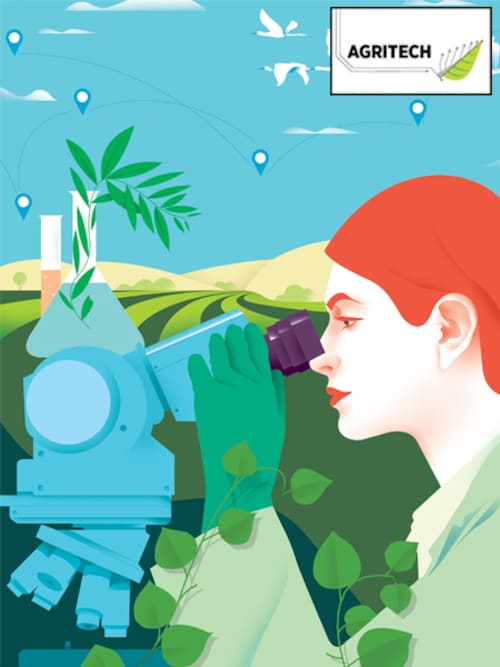How to reshape the future of Indian agriculture
Innovation in agrifood life sciences is the need of the hour. The fledgling ecosystem needs to be revitalised with talent and capital, Mark Kahn, managing partner and cofounder, Omnivore, writes


Less than a decade ago, channeling capital into India’s now-thriving agritech sector was a Herculean task. Before the ubiquity of mobile data and smartphones across rural India, venture capital (VC) investors focussed on urban themes, including ecommerce, e-grocery, and restaurant delivery. Around 2016, when these categories consolidated around a few unicorns, mainstream VC investors began exploring B2B themes and agritech popped onto their radar, which is appropriate given that around 25 percent of India’s economy is agriculture and agribusiness. As of 2022, India has the third-largest startup ecosystem globally and ranks third after the US and China in agritech funding. However, agrifood life sciences (AFLS) as a sub-sector of agritech is yet to experience the same boom in entrepreneurship and funding.
We think about agrifood life sciences as including four broad categories: Agricultural biotechnology, novel farming systems, bioenergy and biomaterials, and innovative foods. Agricultural biotechnology includes on-farm inputs for crop and animal agriculture, including hybrid seed breeding, genetics, microbials, and animal health. Novel farming systems include controlled environment agriculture (CEA), RAS aquaculture, insect protein, and algae production. Bioenergy and biomaterials include agri waste processing, biomaterials production, and feedstock technology. Finally, innovative foods refer to various forms of alternative proteins (plant-based, fermented, and cellular), as well as functional foods and other novel ingredients.
Indian agriculture faces a grim catch-22 situation in the coming decades, where there is an urgent need to increase crop yields to feed a growing population even as increased agri production depletes already declining water tables and soil health. Making matters worse are the advancing effects of climate change. Within a decade, Indian farmers will bear the full force of climate change, and digital technologies alone are insufficient to ensure a bright future in rural India.
Innovations in agrifood life sciences can play a critical role in tackling climate mitigation (reducing India’s GHG emissions) and climate adaptation/resilience (securing a future for India’s farmers). We are also moving towards a more protein-intensive future alongside rising concerns for animal welfare and environmental sustainability. Agrifood life sciences have the power to transform India’s bounty of millets and pulses into innovative plant-based proteins to meet global demand.
ALFS can even reinvent entire agricultural value chains, for example, replacing unsustainable ingredients like fishmeal with insect protein, creating a circular economy at scale. Finally, biological substitutes can be developed for chemical fertilisers and pesticides, simultaneously improving human and planetary health. There are innumerable challenges ahead for India, but agrifood life sciences can solve them with innovations.
Agrifood life sciences are the most neglected aspect of agritech in India’s startup ecosystem. Globally, $6 billion was invested in AFLS startups in 2020, while in India, only $10 million, in aggregate, was raised by startups tackling these immense challenges. India is becoming a global outlier, with the US, Israel, Europe and China all building unicorn startups in agrifood life sciences. The lackluster state of entrepreneurial activity in this category in India is mystifying. More so when we consider how innovations in synthetic biology, chemistry, and biotechnology have the power to catapult Indian agriculture and food to a profitable and sustainable future.
Many blame India’s de facto ban on new transgenic traits in seeds, but this is a flimsy argument since we also lack startups in biological crop inputs, microbial biotechnologies, cellular alt protein, and animal/aquaculture health products. In part, the answer lies in the lack of world-class talent. In the digital startup ecosystem, over the past few decades, entrepreneurs and investors returned to India with global exposure. In contrast, Indian life sciences talent continues to migrate abroad at the earliest possible opportunity and rarely returns home. In India, scientists are not considered wealth creators, and there is very limited spending on R&D domestically.

It is clear we can no longer afford anaemic progress in agrifood life sciences. The fledgling ecosystem needs to be revitalised with talent and capital. In spite of painting a rather sad picture of the current state of affairs, it would be unfair to lose sight of India’s strong universities and research institutions shaping future life science innovators. Now is the time for VC investors to step forward and help reshape the future of Indian agriculture and food systems. On our part, Omnivore has launched the OmniX Bio initiative to back early-stage agrifood life science startups. OmniX Bio aims to catalyse venture capital towards India’s nascent agrifood life sciences ecosystem and also provide mentorship from global agrifood life sciences leaders, institutional partnerships, and business development support to access domestic and export sales channels. The path ahead for Indian agrifood life sciences might not be an easy one, but it is definitely the surest way to ensure a truly atmanirbhar future of India.
(The writer is managing partner and co-founder, Omnivore)
First Published: Sep 12, 2022, 11:16
Subscribe Now